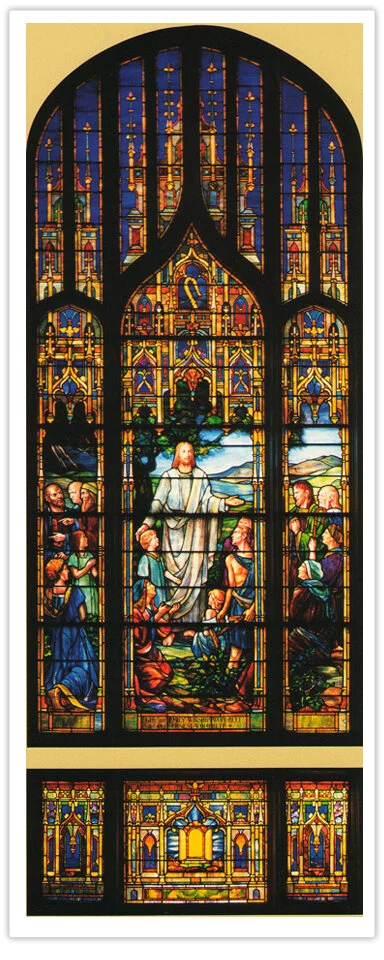
Stained Glass Windows
WINDOW NAME
Jesus’ Ministry (Christ’s Life and Ministry)
Location
North Wall
Date Installed
July 9, 1939
Executed by
D’Ascenzo
Given by
Ernest and Emily Woodruff
Illustrating
Luke 22:24-27; John 13:1-16; Philippians 2:1-11
In Dr. Lyons’ words:
In this window we have pictured one of the epochal periods of our Savior’s life—His brief ministry of some three years. In ignorance, sin, and bodily weakness are men, women, and children. Unto them He went teaching, forgiving, healing.
The small scene at the bottom shows the open door. “I am the door: by Me if any man enter in, he shall be saved.”
The trefoil depicts Jesus during the three years of his ministry engaged in teaching, healing, preaching. Notice the people crowded around him. Here are every type of person, well dressed people, poverty stricken people. The man just under Christ's left hand is the “lame man” who Christ raised to walk again. The scene includes children, grown people, old people, all worshiping Christ. In the left panel everybody is looking at Christ and listening to his words except three men at the top of the panel. They are turned away from Christ and represent those Jewish people who were plotting even then to kill Christ.
Above their heads, are two streaks of light which represent lightning, indicating the great upheaval that is to come, caused by the determination of these people to destroy Jesus Christ and stop his teaching.
The scene above shows the shepherd’s crook indicating that Christ came to save the lost sheep.
A story about this window gives another example of the close interplay between the designer, the artist, and the craftsman in carrying out the vision. The lame man is standing just to the right of Jesus under His left hand. In the original artist’s drawing, the lame man was lying on the ground, clutching his crutch.
Dr. Lyons wrote to D’Ascenzo (21 Nov 1938):
I am thoroughly convinced that a man who had been a cripple all his life and had just been healed by the Saviour should not only break his crutches and throw them away, but should have his religion in his legs and be standing on them expressing love and gratitude.
Following this discussion, the artists depicted the man standing and holding his broken crutch. Clearly he needed to be holding his crutch so we could identify him.


